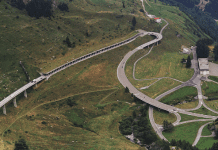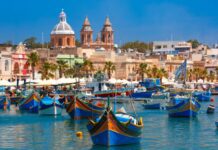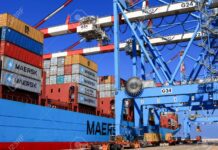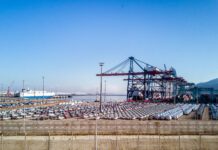As an integral member of the European Union, Ireland has direct access to some 500 million customers. 75% of Ireland’s trade is done with continental Europe and with Dublin Port just adding another string to its bow with the announcement of Celebrity Cruises coming to Home Port , the burgeoning port of Dublin is set for busy times. Patricia Cullen gives us the lowdown from Dublin Port; the new “Gateway to Europe”.
Trials and tribulations for Irish businesses intensify as the EU turns 60, but the Irish economy is facing the challenges head on. Ireland, for the first time in seven years, reached net migration last summer, attracting as many people as it was losing, and consequently is enjoying a healthy and headstrong talent pool. With more than 1,000 overseas companies operating in Ireland, employing approximately 150,000 of the country’s 1.9m workforce, an increasing number of global companies are looking to Ireland to set up operations to access the lucrative European market.
The nation is already favoured by some of the world’s most influential firms including Apple, Microsoft, Google, and Facebook because of its great geographical location, its highly skilled workforce, generous tax rates and high quality of life.
In 2017, resilient FDI will help investment grow by 6.8%, the country’s GDP is projected to increase by 3.7% and consumer spending is expected to expand by 3%.The total number of people in employment will continue to grow, with the potential for average salary increases of 5% – 10% in the ICT, Science, Engineering, Accounting and Financial Services sectors. The FDI employment demand is strong, tracking ahead of the Horizon 2020 employment creation targets and last year’s 5.2% growth rate has meant that Ireland has remained the fastest growing economy in the EU for the third consecutive year.
The Irish economy performed strongly even in the initial months after the Brexit vote and Irish owned enterprises experienced growth of 3.2% signifying there are little or no signs as yet that the UK’s choice to leave the EU will damage Irish trade. As the UK is moving towards a ‘hard Brexit’, the feasible loss of financial services ‘passporting rights’ for London based firms will potentially raise the quantity of prospective relocations to the capital city of Dublin.
There have been some concerns around limitations on trade and movement between the UK and Ireland post-Brexit, but it’s difficult to see how this would benefit the UK, economically, politically or socially. Therefore, it is hoped that Brexit won’t bring with it any major, lasting or long-term negative impacts on Irish business.
On the contrary, some British-based financial services firms have already decided to relocate at least part of their operations to Ireland.
It is possible that FDI which previously flowed into the UK could instead flow to Ireland if foreign firms are looking for an alternative gateway into the EU market. Dublin recently ranked 34th out of 231 global cities on the Mercer Quality of Life Survey 2017, positioned higher than London, which came in 40th. The city’s strengths are widespread and span the economy, environment and culture. The Irish capital continues to be an attractive option for businesses seeking a base in north-west Europe, at a substantially lower cost than Paris. Dublin saw new businesses exceed 20,000 last year for the first time in almost 20 years, and obtained third place in the ‘Global Cities of the Future’ list of top cities in the world for attracting FDI, in both economic potential and business friendliness subcategories.
The Irish ports are vital gateways to UK and European markets, especially Dublin Port, which has grown by 25% in the last 4 years alone and some 80% of the goods that come into Ireland come in through this port. Dublin Port Company has announced that it will pay a dividend to the State of €11.7m in 2017, bringing the aggregate dividend payment since 2007 to €101.2m. Healthy trade statistics for the first quarter of 2017 show continued strong growth of 4.2% after last year’s record throughput of 34.9 million gross tonnes, consistent with the robust recovery evident in the domestic economy. The current pace of growth is so strong that Dublin Port is now on course for another record year for the fourth consecutive year. The largest part of Dublin Port’s business is roll-on/roll-off freight trailers and lift on/lift off containers. The former grew by 7.7%in the first three months of this year while Lo-Lo containers grew by 0.1%. Notably, this excellent level of growth is not limited to Ro-Ro freight trailers and Lo-Lo containers, but also stretches to cruise tourism.
Dublin Port has many more strings to its bow, with cruising at the helm. From approximately 30,000 passengers in 2003, Dublin hosted nearly 160,000 cruise passengers in 2016 and is expecting approximately 200,000 this year. Developing more adapted infrastructure for cruise ships is a primary focus, and implementation of the Alexandra Basin Redevelopment Project will provide new berths for shipping and allow larger, longer ships to routinely call at the port and turn within the expanded Alexandra Basin West and berth further upriver, luring even more cruise ships and an extra 600,000 tourists to Dublin. The €230 million ABR project is expected to complete by 2026. Amongst other improvements in the Masterplan is the development of the Dublin Inland Port on 44 hectares of motorway connected lands adjacent to Dublin Airport. This will provide scope to store 20,000 empty shipping containers, and in doing so, release 30 hectares in the port for core activities.
Celebrity Cruises is set to become the first major cruise line to home port in Dublin. From 2018 you will be able to take a cruise to the Norwegian Fjords, and over 14,000 people are expected to begin their holiday from Dublin Port in 2018. Celebrity Eclipse will make her maiden call to Dublin Port on 10th May. Ireland’s largest cruise port shows considerable capacity for further development as a marquee destination and is seeking to become a ‘turnaround’ port for cruise ships by 2020. This will entice more bed-nights and business and create discretionary spend for the city’s economy given that homeporting passengers normally spend three to four days either side of their departure or arrival visiting the city and nearby counties.
Lending a hand to realise this vision is Cruise Dublin, the new Cruise Tourism Development and Marketing agency established last year to promote Dublin as Ireland’s premier port of choice for all things cruise. Last summer we saw a rise in cruise ships stopping at Dublin Port, bringing an influx of visitors into the city centre with an average spend of €100 per passenger, resulting in a €1.6 million boost for the Dublin economy. Additionally, a 4.2% increase in freight volumes in the first three months of this year, on the back of increasing volumes of imports and exports, brings more good news. Volume growth is expected to top 3.3% per year up to 2040.
Dublin Port aims to become a turnaround hub for the world’s largest cruise liners, with €600 million planned redevelopment in the pipeline. Current projects underway will transform the Ports ability to handle larger ships and increase trade volumes giving it a head-start on other European cities. Total throughput for the first three months of this year was 8.7 million gross tonnes with 1,843 ship arrivals, equivalent to 20 ships each day, and this number is only set to rise.
Dublin’s coastal location, new cruise marketing agency and grand masterplan to guide development until 2040 are ensuring that this is one exciting voyage.













































